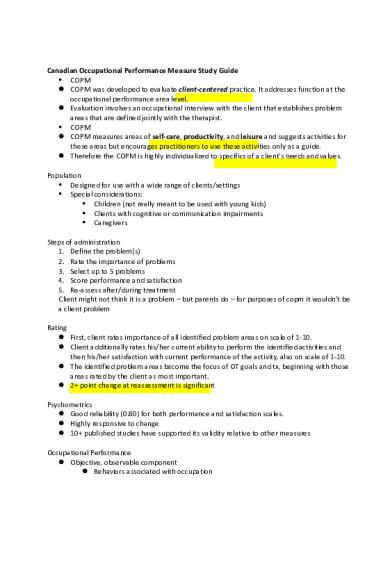Canadian Occupational Performance Measure Study Guide PDF

| Title | Canadian Occupational Performance Measure Study Guide |
|---|---|
| Course | Techniques & Tools for OCTH Pr |
| Institution | Xavier University |
| Pages | 3 |
| File Size | 69.3 KB |
| File Type | |
| Total Downloads | 22 |
| Total Views | 123 |
Summary
COPM study guide for exam...
Description
Canadian Occupational Performance Measure Study Guide COPM COPM was developed to evaluate client-centered practice. It addresses function at the occupational performance area level. Evaluation involves an occupational interview with the client that establishes problem areas that are defined jointly with the therapist. COPM COPM measures areas of self-care, productivity, and leisure and suggests activities for these areas but encourages practitioners to use these activities only as a guide. Therefore the COPM is highly individualized to specifics of a client’s needs and values. Population Designed for use with a wide range of clients/settings Special considerations: Children (not really meant to be used with young kids) Clients with cognitive or communication impairments Caregivers Steps of administration 1. Define the problem(s) 2. Rate the importance of problems 3. Select up to 5 problems 4. Score performance and satisfaction 5. Re-assess after/during treatment Client might not think it is a problem – but parents do – for purposes of copm it wouldn’t be a client problem Rating First, client rates importance of all identified problem areas on scale of 1-10. Client additionally rates his/her current ability to perform the identified activities and then his/her satisfaction with current performance of the activity, also on scale of 1-10. The identified problem areas become the focus of OT goals and tx, beginning with those areas rated by the client as most important. 2+ point change at reassessment is significant Psychometrics Good reliability (0.80) for both performance and satisfaction scales. Highly responsive to change 10+ published studies have supported its validity relative to other measures Occupational Performance Objective, observable component Behaviors associated with occupation
Subjective, experiential component Cognitive and affective experiences associated with those behaviors Assumptions Clients know what they want in terms of their occupational performance. The only relevant frame of reference of therapy is that of the client. The therapist cannot actually promote change; he or she can only create an environment that helps client facilitate own change. What I think the client needs doesn’t matter – only what’s relevant to the client. Change will only happen if the client wants it to, but we use therapeutic use of self and other modalities to facilitate change Advantages of Client-centered Approach Enhance the sense of mastery and control among clients. Assessment of occupational performance supports individualized approach to therapy. Provides opportunity for the therapist to learn more about occupational performance from each new client. Many clients lack a sense of mastery – perception of health care professional as benevolent/omniscient expert who should tell them what to do (generational difference?). Move toward collaborative partnership in health care. Advantages Client perspective guides process Directly measures occupation Considers the client’s environment, developmental stage, life roles, and motivation Addresses client specifically; not diagnosis-specific Demands practitioner-client collaboration Quantifiable results Disadvantages: Numerical values may not represent the equivalent degree of change in ability or satisfaction when outcomes of two or more clients are compared Have you been at any sites that use this assessment? CCHMC for sure. Can be used with the client or their caregiver, as you will see in the video. Can’t really compare between clients
Your assignment: Find someone to interview using the COPM Someone you do not know well Difficulties in one or more areas of occupational performance, whether or not they have a diagnosed disability or medical condition, or a caregiver Self-assessment Did you feel comfortable doing it Occupational profile (AOTA form)
Manuals available in ADL lab TheCOPM.ca for special situations Helpful Hints Keep in mind – who is your client? Ask probing questions Avoid jargon Use manual as a guide for types of occupations Redirection and therapeutic use of self Do not need to complete reassessment scores ...
Similar Free PDFs

Measure for measure revision
- 7 Pages

Measure FOR Measure PLAY Summary
- 3 Pages

Occupational therapy
- 27 Pages

Occupational adaptation
- 14 Pages

Occupational Profile
- 2 Pages

Sappho+Study+Guide - Study Guide
- 5 Pages

Study Guide - HR - Study Guide
- 17 Pages

Occupational Therapy Process
- 6 Pages

Pawlowski Occupational Rights
- 4 Pages
Popular Institutions
- Tinajero National High School - Annex
- Politeknik Caltex Riau
- Yokohama City University
- SGT University
- University of Al-Qadisiyah
- Divine Word College of Vigan
- Techniek College Rotterdam
- Universidade de Santiago
- Universiti Teknologi MARA Cawangan Johor Kampus Pasir Gudang
- Poltekkes Kemenkes Yogyakarta
- Baguio City National High School
- Colegio san marcos
- preparatoria uno
- Centro de Bachillerato Tecnológico Industrial y de Servicios No. 107
- Dalian Maritime University
- Quang Trung Secondary School
- Colegio Tecnológico en Informática
- Corporación Regional de Educación Superior
- Grupo CEDVA
- Dar Al Uloom University
- Centro de Estudios Preuniversitarios de la Universidad Nacional de Ingeniería
- 上智大学
- Aakash International School, Nuna Majara
- San Felipe Neri Catholic School
- Kang Chiao International School - New Taipei City
- Misamis Occidental National High School
- Institución Educativa Escuela Normal Juan Ladrilleros
- Kolehiyo ng Pantukan
- Batanes State College
- Instituto Continental
- Sekolah Menengah Kejuruan Kesehatan Kaltara (Tarakan)
- Colegio de La Inmaculada Concepcion - Cebu






